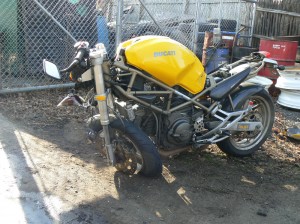
Crashing a motorcycle sucks. No doubt about that. I’ve had my share of run-ins with gravity and it’s not fun. But, does crashing a motorcycle always mean carnage and a hospital visit? It depends.
My crashes
I’ve had only one “real” street crash and one minor one. The minor one involved a car who rolled into the back of my Triumph Bonneville. I didn’t fall, so it was very minor. I also had a minor parking lot tipover (note to self: remove the disc lock before attempting to ride away). But tipovers aren’t exactly what I call “crashes”.
The “real” crash happened in 1978 when a car driver turned left in front of me…classic.
Thankfully, most of my crashes were racing incidents. I say “thankfully” because even though racing crashes suck, they don’t suck nearly as much as street crashes where the chances of injury after sliding into a tree, guardrail or oncoming car is quite high.
I’m truly grateful that the extent of my injuries from both track and street crashes were cracked ribs and a broken foot from the tipover. These injuries were painful, but all healed without any complications.
Unfortunately, the “real” street crash resulted in a totaled 1973 Yamaha TX650 and the rear-end incident resulted in the Triumph’s taillight being smashed, but that’s what happens when you make impact with cars.
In all of the track crashes, bike damage was limited to easily replaceable parts, allowing me to get back on the track later that day. Sure, the cosmetic damage was a bummer, but I got over it–most people do.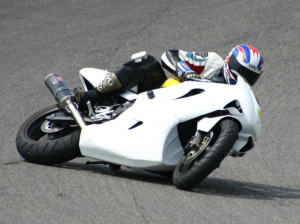
Safer Crashing
There was a time when crashing on the racetrack was just as likely to get you killed as crashing on the street. This was because racetrack safety was abysmal with concrete walls lining the course and pavement not any better than a potholed rural road.
Thankfully, track safety is much improved. Even though a lot of people complain about the safety issues at my local track (Loudon, NH), the current track is much better than the old Bryar track that had all sorts of safety problems. We didn’t complain much, since all of the tracks were that way.
Another reason there are fewer deaths and injuries today is because of better protective gear. Pudding bowl helmets lined in cork were the racers’ choice at one time. Now, we have helmets that are pretty darn effective at preventing the majority of head injuries. Add to that the improvements in material and armor incorporated into jackets, pants, boots and gloves and it is possible to crash without suffering too badly.
Of course, where you crash is the biggest factor in whether you will end up in a hospital or hearse. Collide with a car and even the best riding gear is not likely to save you from some kind of injury. Crash on a modern racetrack, and you’ll likely get up, brush yourself off and walk back to the pits under your own power.
Unfortunately, road safety has not improved for motorcycle riders. More tar snakes and guardrails seem to appear every year and drivers are more and more careless about paying attention. And road conditions are often allowed to get pretty bad before they are fixed.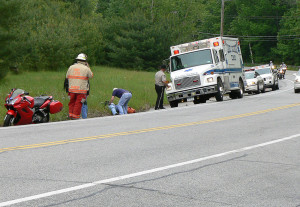
Perception of Risk
It’s been proven that people take greater risks when they feel protected. This is why drivers of large SUVs tend to feel less threatened than drivers of small cars. Most motorcycle riders understand that they are vulnerable to injury and ride accordingly.
This is why Risk Ignorance and complacency is so dangerous. The risks don’t change, but the inaccurate perception of the danger can make a rider think he or she can ride more aggressively or with less attentiveness.
Believe it or not, there were fewer racing crashes back in the day when races were held on road courses lined with stone walls, hedgerows, fences and houses lining the circuit. Racers knew that a fall would very likely result in death. So, most rode in a way that balanced risk and reward.
Today, there are many more crashes, but many fewer deaths and serious injuries because, with the exception of the Isle of Man and a few other “real” roadrace circuits, racing is conducted on closed courses with safety features such as runoff, gravel traps and airfence. Also, today’s protective gear is so much better. This means that racers can push harder, knowing that a crash will probably not be the end of the world.
Now, don’t get me wrong, racetrack crashes can be lethal. It’s just that the risk to reward ratio has shifted so that it’s not unreasonable to expect to get up unscathed after a racetrack crash.
The Perception of Crashing
Another advantage racers have when it comes to crashing is that racers expect to crash. After all, they are pushing the limits of grip and skill and are sharing the track with a bunch of crazies all set on going as fast as they can, determined to take your spot on the podium.
So, when you do crash in a race situation, it’s not unexpected. And if you do go down, it’s unlikely that you are seriously injured, so you get over it rather quickly. This makes the mishap psychologically easier to deal with.
It’s different when you don’t expect to crash. For instance, crashing during a track day will likely be more upsetting, because it is not assumed that crashes are inevitable. But, track day crashes still fall under the category of “not likely to get injured”, so most track day crashers get over the mishap fairly easily.
Crashing on the street is a whole other matter. Street crashes are often particularly traumatic, not only physically, but also mentally. Most street riders assume that they will not crash, even though the risks are actually much greater when riding on the street. It’s understandable, because most street riders go many miles and years without a crash, which makes it easy to think that it won’t happen to them. So when it does, their world is shattered, even if they don’t suffer a significant injury.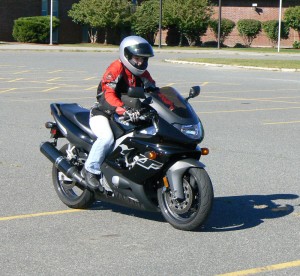
Thankful, But Skillful
I’m able to write about my crashes today, because most happened on the racetrack in a controlled environment. I’m thankful that I have experienced very few street crashes.
Perhaps some of the reason why I’m still in one piece is luck, but I contend that the reason I have had few street crashes is because of my commitment to riding smart and never becoming complacent about risk. This includes learning all I can about riding and implementing effective strategies when riding in traffic or in the twisties.
Risk is always there and always will be. Learn to manage risk and perhaps you can join me as one who is mostly unscathed after many decades of riding a motorcycle…if we stay sharp and are blessed with a bit of luck.
What have you learned from your crashes?
Please Donate to Keep the Articles Coming
If you liked this article and the many other articles on this site, please toss a buck or five into the hat. It’s greatly appreciated!
- Click the PayPal “Pay Now” button.
- Then indicate quantity in $2.00 increments. – Example: put “2” in “QUANTITY” field to donate $4.00, “3” for a $6.00 donation, etc.
Why $2.00? Due to the PayPal fee structure, a $2.00 donation is significantly more beneficial compared to a $1.00 donation.
Thank You!
Check out these posts:
- Product Review: TCX X-Desert Boots
- Get Anxiety & Stress Under Control (Motorcyclist)
- KLX250s Upgraded and Accessorized
- Street Triple R Gets Accessorized
- Triumph Street Triple R Review
- How To Survive Mid-Corner Hazards
- #1 Reason for Motorcycle Crashes in Corners
How Can I help You? Online Coaching NOW AVAILABLE
Stay Informed: Subscribe NOW!
 Be a Better Rider: Sign Up for Personal Training with Ken
Be a Better Rider: Sign Up for Personal Training with Ken
Support Riding in the Zone: Buy a book
Support Riding in the Zone: Buy products from Twisted Throttle & Amazon
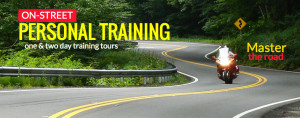








Something to think about after you’ve crashed; or maybe before? As you say, Ken, physical recovery is common.
But the mental aftermath of crashing is powerful, maybe even traumatic — In 2010 I dropped an expensive rental bike on the Pacific Coast Highway (20mph tight uphill hairpin) and I still find myself trying to explain it. I’m not used to crashing, and this one was a total surprise.
Post-crash analysis led to speculation as to my competence, but also to an instinctive attempt to blame the bike (BMW R1200RT), the road (torn-up shallow pothole right on my line), the sun in my eyes — anything to ease my guilty suspicion that I failed.
Whether single vehicle incident or involvement with the road or other road users I’ve heard many people blaming the crash on something external — the “other”
It takes an effort to clear out all this mental junk and focus on what’s really practical: Improve your riding! Decide you did something wrong then fix it! Practice!
Make that crash a constructive lesson. Include near-misses while you’re at it.
Yeah, trying to deal with the aftermath of a crash can be very difficult. I wrote an article on dealing with a crash that appeared in a recent issue of Motorcycle Consumer News. Learning from your mistake is important for moving on. Hopefully, there is enough data to explain what went wrong. Without that, you’re kinda left with wondering. Also, many people end up with varying degrees of PTSD even if they weren’t injured.
Good read Ken.
I’ve never had a street crash in my riding career thus far so I only have crashes from the race track to go off of. In my experience crashing is the most exhilarating part of my motorcycling experience. There is absolutely nothing like the feeling of skipping across the pavement at high speed. I have been lucky to not get seriously injured, so that also potentially creates the nonchalant atmosphere that focuses solely on the excitement at hand.
Perhaps I’ll have more to say on this after I get back in the saddle from my first track crash. The only thing that has stopped me is the doctors otherwise I would’ve been out there! I’ve tipped over at traffic lights and such and those aren’t crashes in my opinion but a tip over is a tip over. As I review my crash I’m grateful it was on the track at speed and not a tip over at a light. My non riding friends never will understand this. Here’s how I see it; in the traffic light scenario the bike can crush me inflicting more injury depending on the angle I catch it. Drivers can clip me on the ground trying to manuver around the scene. In the track scenario at speed I tip over and roll away from the machine and danger. (I know this an ideal crash scenario and happens to be my experience) Care or help is likely on the scene due to track rules or state laws. On the road I have to hope my phone wasn’t crushed or thrown out of reach, hope someone is sympathetic to help if I can’t take care of myself, and wait for care or help.
Here’s to my first track crash and learning a ton this year! Can not wait to get back out there!
Thanks ken!
I also had my first crash, street or track, a few months ago. A worn rear tire and the beginning of a rainstorm led to my lowside at Thunderbolt. Luckily I was uninjured, with only minor damage to my bike, and only a couple light scrapes on my gear and helmet. I only missed one session, and at the end of the day I still had a smile on my face. I’ll gladly take that over a street crash any day!
Cassie – hope you’re healing up well, see you at the track in 2014 🙂
Some great points made in this blog. I had a similar street crash to Ken’s a few years back. While leading a group of 7 riders through rural streets in RI, an unexperienced cage driver took a left turn in front of me, saw me, panicked, and stopped in my lane. Having only a couple of seconds to react, I tried to apply what I learned on the track. Unfortunately, the initial brake application met with gravel in the road and I washed the front tire. Luckily, I slid away from the car. The bike wasn’t so lucky. It hit the car dead on and it was totaled.
I was wearing full gear leather jacket & pants, gauntlet gloves, full face helmet and boots, as I usually did while riding on the street and my only injury was some pulled ligaments in my left shoulder. I did take an ambulance ride for precautionary reasons. But I walked away from the incident without any batle scars because of the gear I was wearing.
Since that accident, I have lost most of my interest in street riding. Even after I replaced the totaled bike with the exact same model, the fun just didn’t seem to be there. I found myself second guessing every other driver on the road.
I guess what I’m trying to say is that for some people, a “bad” crash tends to change your perspective on riding. So, for me, the anticipation of that first ride on the track every season is high, since I rarely ride on the street now.
Great article/subject
As stated earlier, self post-mortem on why you crashed and being honest and truthful to yourself is critical to move forward – learn from the incident.
Unfortunately, many times the equipment is blamed, such as, “my tires let me down and flipped me off the bike”. Reviewing the crash and making a comment like, “your tires look worn down (implying skill set issue with throttle in less than optimum traction situation” brings a reply, “Like I said, my tires let me down”.
The movie line comes to mind, “your ego is writing checks your body can’t cash”.